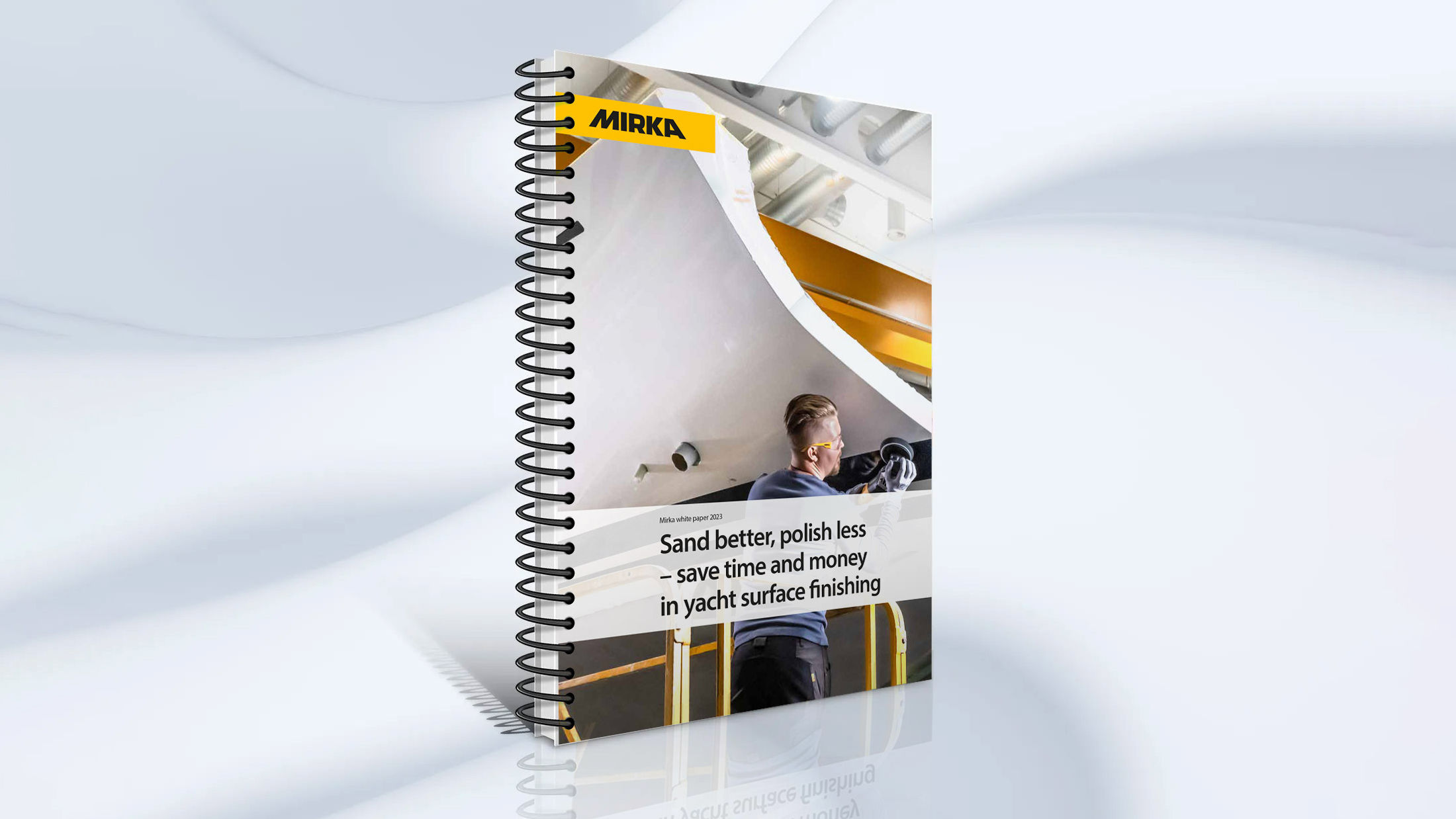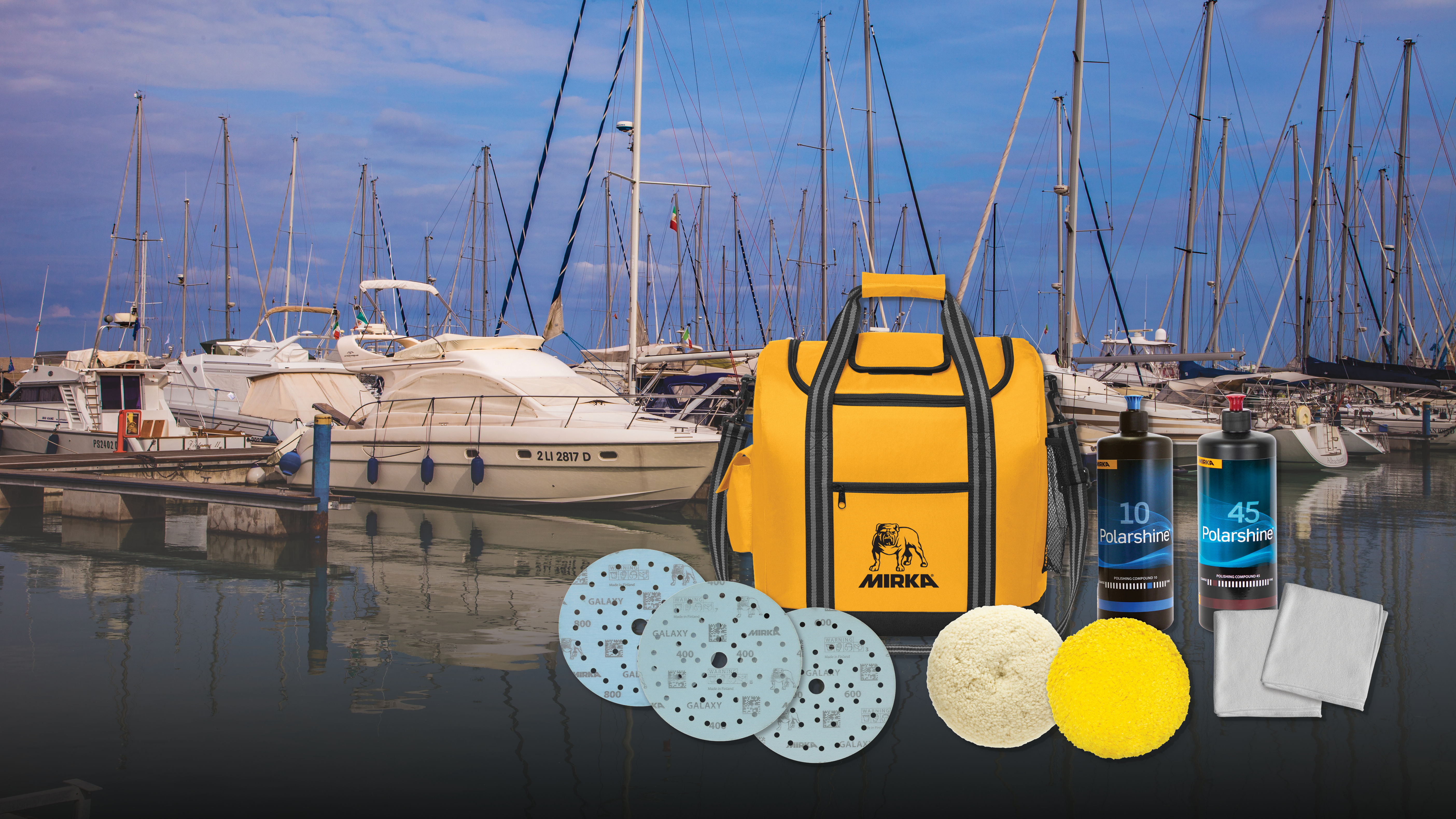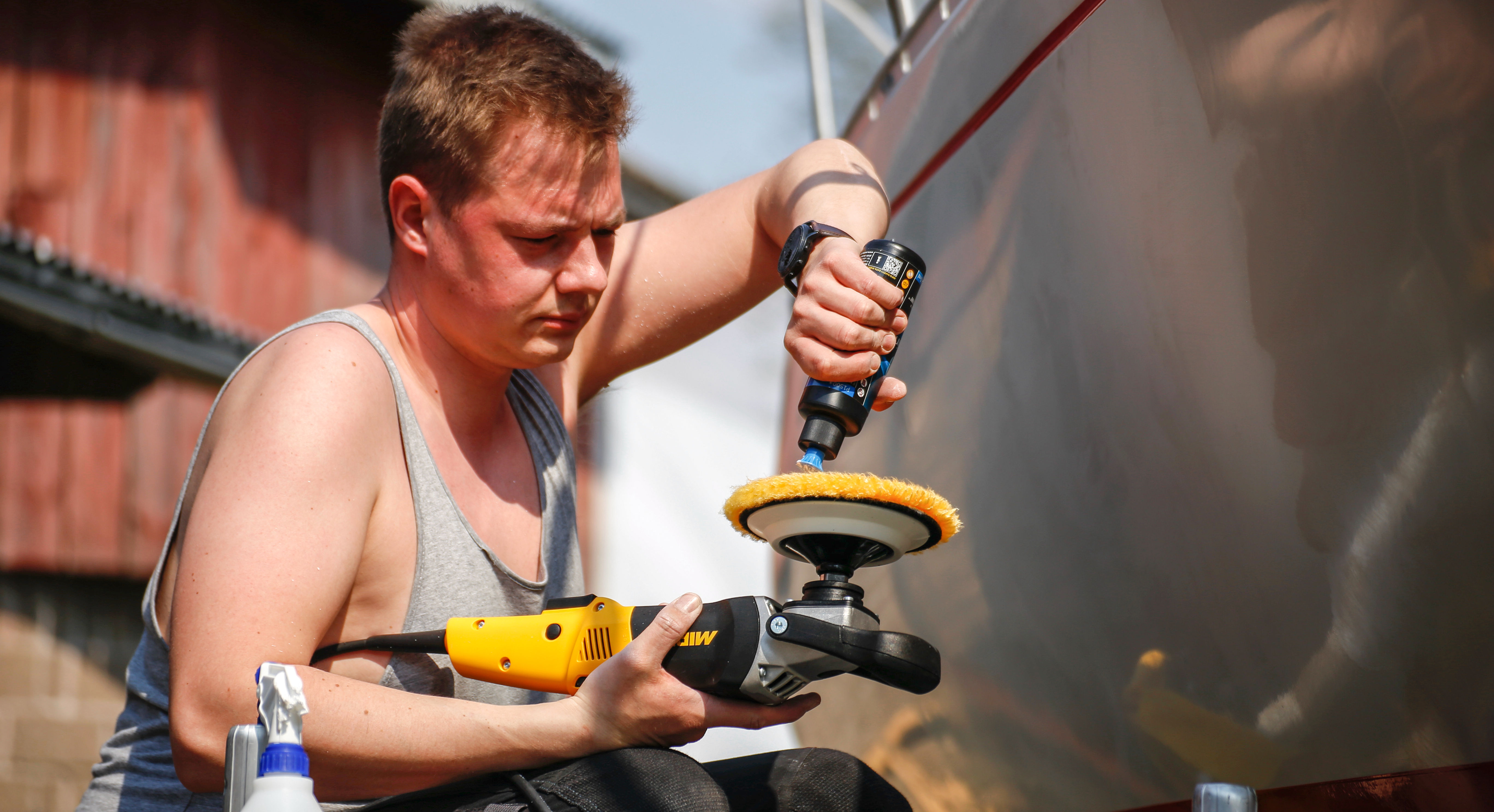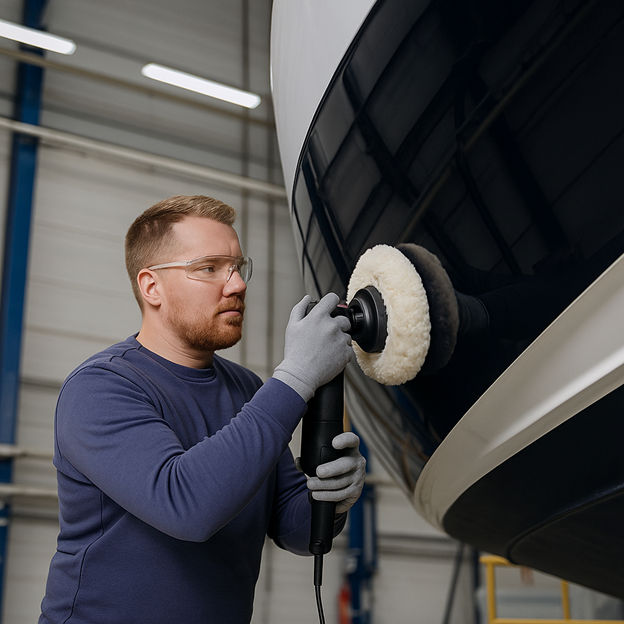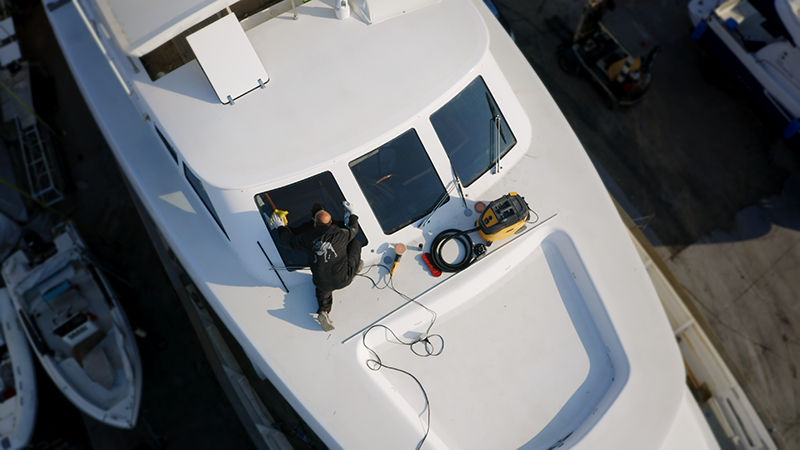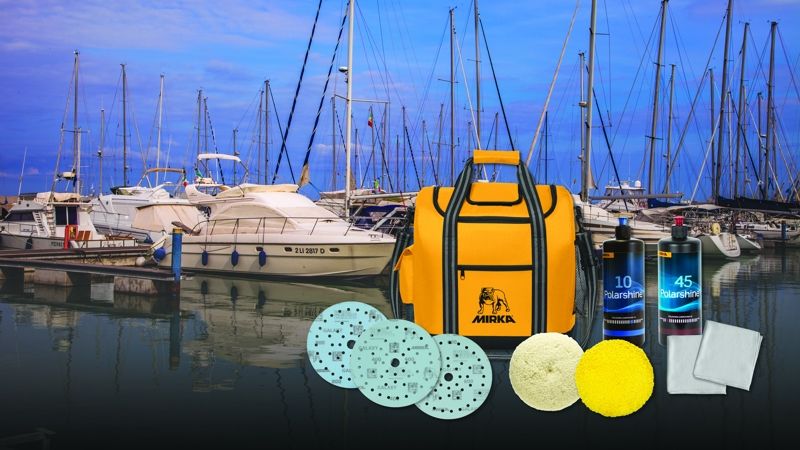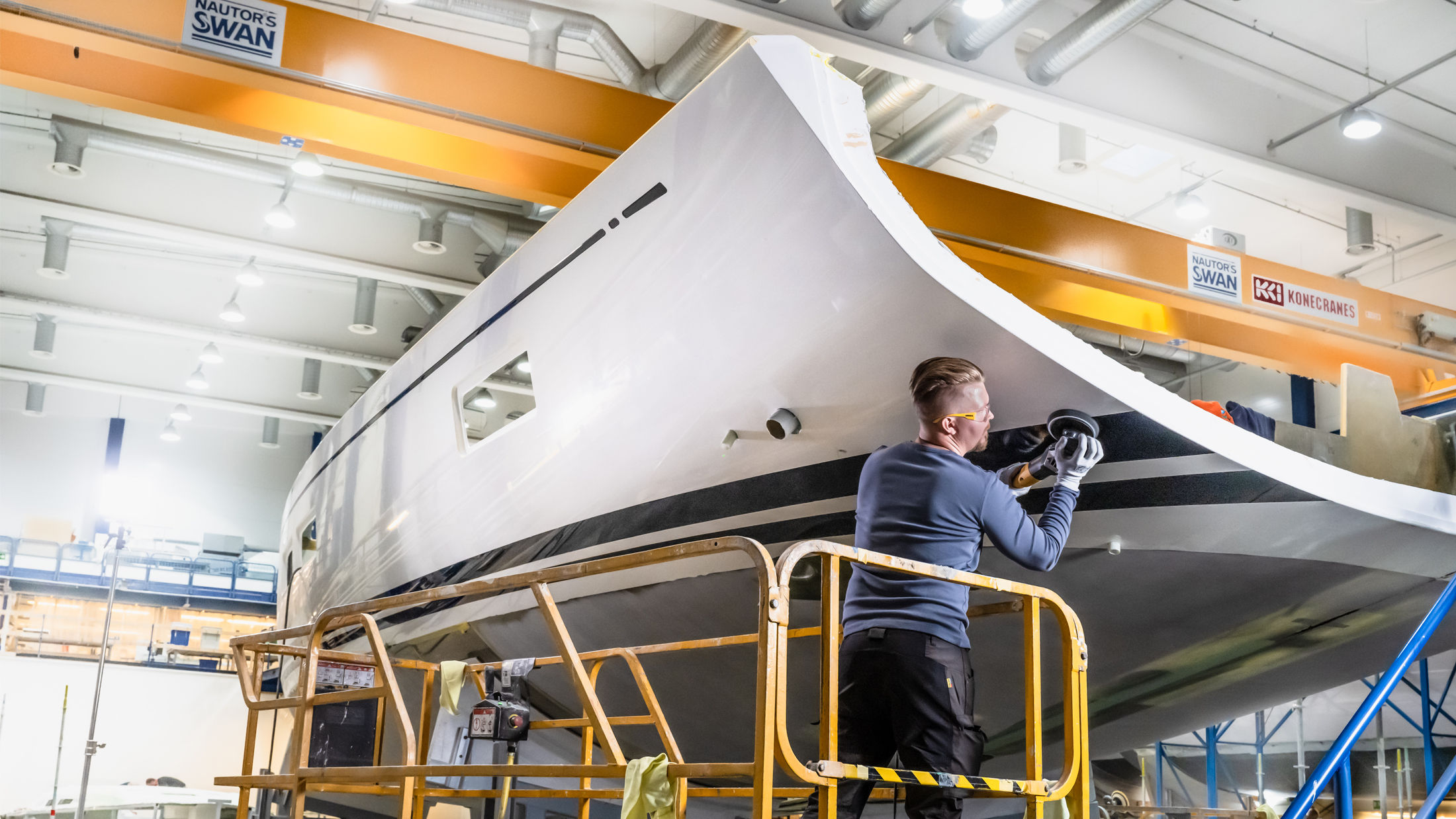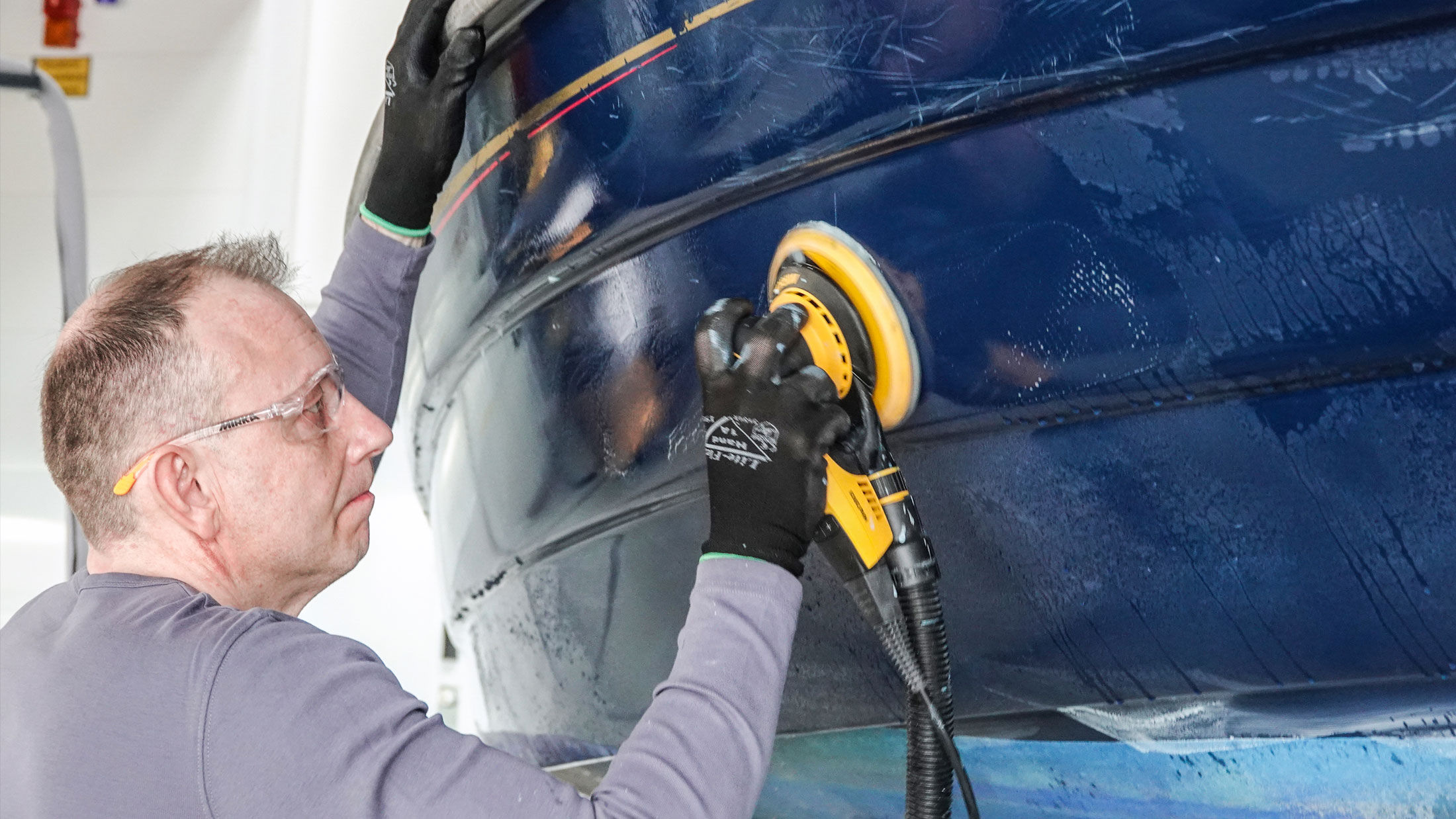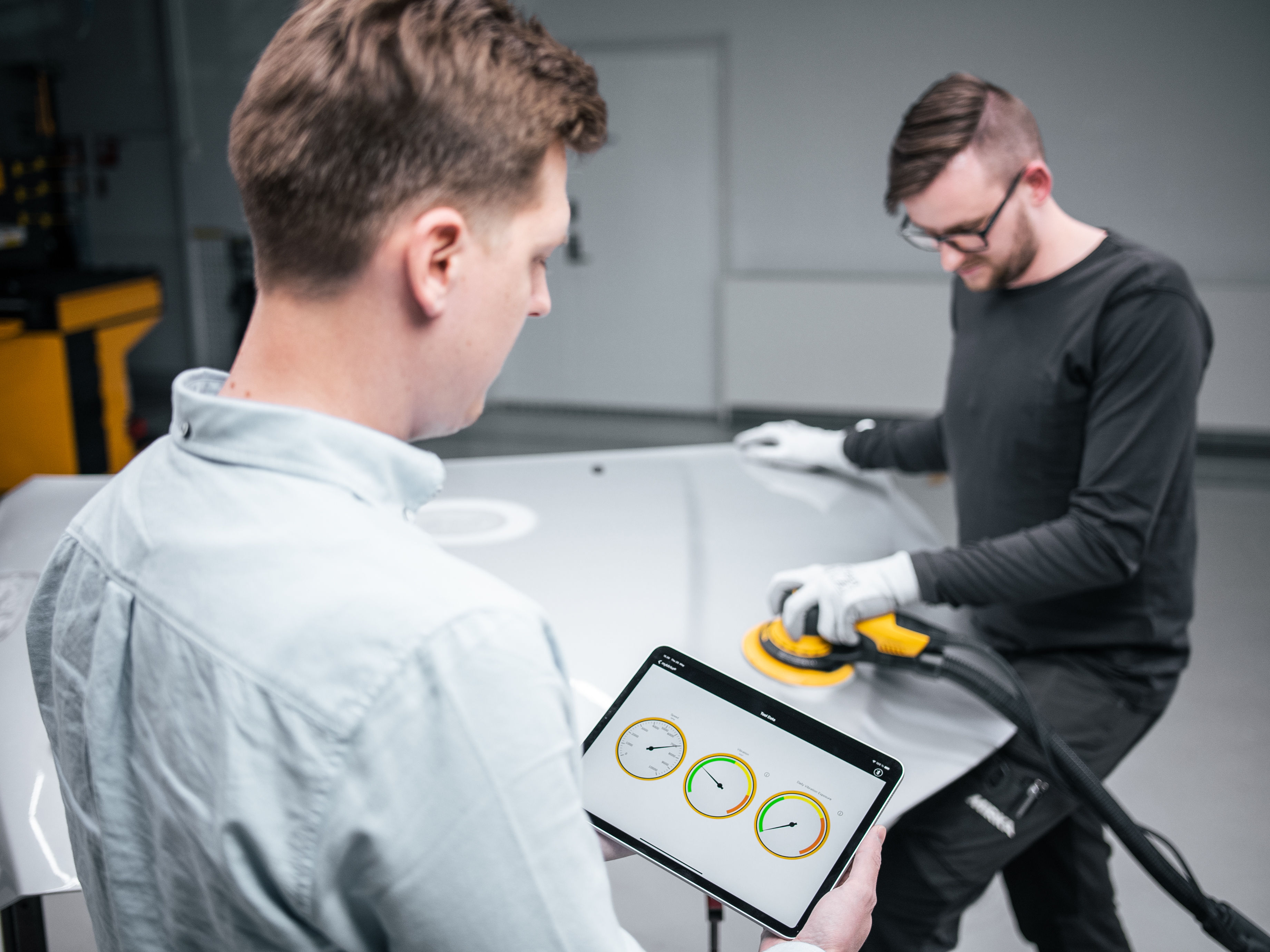2+1 years
Register Your Tool
All Mirka power tools have a standard two-year warranty. Get an additional 1 year of warranty free of charge by registering your tool within 30 days of purchase.
Keep your tools in excellent shape on myMirka where you can register, manage and order repair for your tools.
Replenish your stock, access marketing materials, view sales guides and read about upcoming product launches.
Steady grip. Less than 7 lbs. High flexibility.
The Mirka® LEROS-S features the well-known benefits of the LEROS, but in a shorter, easier to handle length. This makes LEROS-S perfect for sanding larger areas, such as yachts and boats, faster. The LEROS-S has two dedicated grip points for full control.
Thanks to its lightness, balance and easy maneuverability, the LEROS-S makes it possible to sand large areas faster and easier. The large sanding pad with its 5mm orbit works especially well in leveling filler.
It features a highly flexible sanding head to make sanding easier and more ergonomic. A better working position makes sanding more effortless and improves the end result as well as productivity.
For effective sanding of hulls
The new Mirka Long File Boards make a difference in hand sanding in marine production. They are a special lightweight construction, complete with an ergonomic grip handle, making sanding hulls faster and more comfortable.
Sanding large surfaces such as the hulls of boats and yachts can be straining and cumbersome, and the Long File Boards have been created to make it efficient and effortless instead.
Get Your Free Copy of Our Whitepaper
To help companies offer more cost-effective surface finishing solutions to their customers as well as a safer working environment to their employees, Mirka has created its own, alternative process that is introduced in this paper.
Learn all about how yacht manufacturers and yacht maintenance companies can save valuable time and money by sanding better and polishing less!
Calculate potential savings in yacht finishing
With our Marine Savings Calculator, you can estimate potential savings using a Mirka finishing process compared to a currently used yacht finishing process. The calculator is suitable for motor boats as well as sailboats.
We offer a wide range of products for various marine surface finishing applications, like sanding yachts, boats, and polishing a boat.
A better choice for you and the environment
All polishes that Mirka produces are water-based and produced in Finland. There are many benefits of choosing a water-based polishing compound.
Solvent-based polishes may be effective in the short run, but they are more damaging and harmful.
Portfolio Manager, Mirka
Save your health, time, and money
Do you get covered in dust when sanding? Try the benefits of Mirka's pioneering sanding solutions and see how a dust-free working environment can boost your business.
Healthier working environment – Stop dust from getting into your lungs
Time-saving – No cleaning after sanding and clean abrasives cut better
Money-saving – No clogging lets you sand longer with the same abrasive
High-quality finish – Thanks to a finer scratch pattern
Cranchi Yachts, Italy
When it comes to creating magnificent yachts, Mirka sanding and polishing solutions play a significant part in achieving the best quality and finish. For Italian yacht manufacturer Cranchi, a high-quality finish is at the core of the business, without compromising the work environment.
"In Mirka, we have found a partner that listens carefully to our needs."
Nautor's Swan, Finland
For Finnish yacht builder Nautor, a high-quality finish is about respecting the company’s roots and heritage, and it takes the best kind of power tools and abrasives to accomplish that. Benny Brännbacka from Nautor shares with us what it means to collaborate with Mirka, and how important client satisfaction is when building spectacular yachts with Mirka's solutions.
"Working with Mirka is very good, we are continuously collaborating."
I recommend Mirka’s Polarshine marine products to anyone who really wants to take care of their boat. The result is amazing, 42-year-old Emma looks new again. I was surprised by the ease of work.
Kristoffer Pietikäinen, Boat owner, Finland
For you and the environment
For us, it has always been clear to not waste financial or material resources – our own or yours. It is equally clear to preserve the planet’s resources. Sustainability, for us, means taking the economy, the earth, and people into consideration when we make business decisions.
We work hard to conserve energy and raw materials, reduce waste, increase recycling, and decrease the use of persistent chemicals. We are developing healthier, safer, and more efficient products and processes so that you will benefit. For example, our dust-free sanding systems help protect the lungs when sanding while giving a cleaner and better surface finish.
For Mirka corporate responsibility is at the very core of how we conduct business. As stated in our values, all parts of our operations are driven to be responsible, committed, innovative and respectful.
In practice, this means ensuring that what we do in terms of sustainability, occupational health and safety, compliance and legislation as well as management systems are an integral part of every department.
Do you want to know more about our marine surface finishing solutions? Please get in touch and our expert support team will answer your questions.
Yacht owners often deal with dull gelcoat, faded color, and swirl marks caused by sun, salt, and frequent cleaning. These surface problems make the vessel look old and increase maintenance time. Many polishing attempts fail because the wrong compounds or tools are used, leading to more damage or poor results.
That’s why choosing the best polish for gelcoat and using the correct process is important for long-term surface protection and appearance.
In this article, you’ll learn how to polish gelcoat the right way and keep your yacht surface clean, smooth, and protected.
Gelcoat is a protective outer layer used on fiberglass boats and yachts. It provides a smooth, glossy finish that protects the underlying material from water, UV rays, and salt. Most marine vessels rely on gelcoat to maintain both function and appearance.
Polishing restores the gelcoat’s gloss and removes surface damage like oxidation and light scratches. It helps extend the lifespan of the coating by sealing pores and protecting against further wear.
Routine polishing also reduces future maintenance costs by keeping the surface smooth and easier to clean.
It also improves fuel efficiency by reducing surface drag on the hull. For professional vessels or high-value yachts, polishing helps maintain resale value by preserving the vessel’s appearance. Regular polishing ensures both functional performance and a clean, professional finish.
Before any sanding or polishing, wash the gelcoat surface with clean water and a mild detergent. This removes salt, oil, and loose debris.
A clean base ensures that abrasives and compounds work efficiently without grinding dirt into the surface.
If the gelcoat shows signs of oxidation, surface dullness, or light scratches, sanding is necessary. Use Mirka® Galaxy abrasive discs from the Marine Polishing Kit 6" Galaxy.
These discs offer long-lasting sharpness and are resistant to clogging. They remove surface defects evenly and help prepare the gelcoat for polishing.
Select the Twisted Wool Pad 6" Yellow for the cutting and polishing stage. This pad is designed for medium-duty polishing with grip backing and soft edges. It is washable and suitable for gelcoat surfaces that need fast correction.
Use the Foam Pad included in the kit for the refining step, especially when working with darker surfaces or finishing passes.
Use Polarshine® 45 for one-step polishing of white or light-colored gelcoat. This coarse compound removes sanding marks from P600 or finer and delivers a deep, permanent gloss.
It is ideal for both production and restoration in marine applications. For darker gelcoat, follow up with Polarshine® 10 to eliminate swirl marks and boost clarity.
Polarshine® 10 is a medium coarse, water-based compound designed to work with Mirka abrasives. It keeps surface temperatures low and permanently removes fine defects. It is silicone-free and can be used with both machine and hand application, making it suitable for all marine detailing workflows.
Complete the process by wiping the polished surface with the grey microfiber cleaning cloth from the kit. This cloth glides easily with low surface friction.
It absorbs residue and allows a clear view of the final finish. Proper inspection at this stage ensures surface quality before delivery or reassembly.
After polishing, regular cleaning helps keep the gelcoat surface in good condition. Use the Grey Microfiber Cleaning Cloth included in the Marine Polishing Kit 6" Galaxy.
It glides smoothly and absorbs residue with low friction. This helps remove dust, water spots, and light surface buildup without causing scratches.
Re-polishing is not part of routine maintenance. Only polish again if the surface becomes dull, scratched, or oxidized. Over-polishing can remove protective layers and reduce long-term surface durability.
Use the same process with Polarshine® 10 or 45, depending on the gelcoat color and surface condition.
UV rays and salt exposure degrade gelcoat over time. Store the vessel under cover or use protective coatings when docked.
Rinse with fresh water after marine use to remove salt. A properly polished gelcoat resists damage better, but ongoing care is needed to extend its life.
Polishing gelcoat the right way helps keep the surface strong, smooth, and easy to maintain. It protects against damage, saves time in cleaning, and keeps the boat looking sharp. A proper polishing process also supports better performance in water.
But the job doesn’t end after polishing. Regular care, smart cleaning, and simple protection steps help keep the shine longer. When done right, polishing becomes a long-term solution, not a short-term fix.
Many boat owners struggle to find reliable repair services that deliver clean, lasting results. Surface damage, fading gelcoats, and poor-quality repairs lead to higher costs and repeat work. This growing need creates a clear business opportunity.
Starting a boat repair business in 2025 can meet this demand if done with the right tools, planning, and skills. In this article, you’ll learn how to set up your marine repair business, choose the right services, manage your costs, and deliver work that earns long-term clients.
Starting a boat repair business means understanding what the work includes and who needs it. This helps you plan your services and tools.
Boat repair covers the inspection and fixing of damage to various parts of a boat. Most repair jobs focus on the outside of the boat, especially areas exposed to water, sun, and wear.
Common repair tasks:
Each repair step needs the right tools, abrasives, and compounds to meet marine standards.
In the U.S., boat repair businesses serve different customer groups. Understanding them helps with marketing and pricing.
Key customer types:
These customers expect high-quality results, time savings, and safe working practices.
Focusing on the right services helps reduce costs and improve efficiency. Start with repair jobs that are always in demand in marine environments.
This is one of the most common repair needs. Boats often get surface damage from wear, docking, or storage. The first step is usually sanding the damaged area.
Typical tasks:
Dust-free sanding tools and systems are preferred to keep the area clean and safe. Mirka’s Abranet® and compatible sanders are suitable for these jobs.
Gelcoat protects the outer layer of most boats. Over time, it can fade, crack, or lose shine. Restoring gelcoat helps maintain both appearance and protection.
Core restoration steps:
Mirka’s Polarshine® compounds are made for gelcoat restoration. Different grades are used depending on the color and condition of the surface.
A boat repair business in the U.S. must follow legal and safety rules. Getting the right licenses and insurance helps avoid delays and protects your operations.
Start by registering your business with your state. You may need local permits, especially if your shop handles hazardous materials or produces sanding dust.
Steps include:
Each state has different requirements, so contact your local business office or small business support center for guidance.
Boat repair comes with risks. Marine insurance protects you, your workers, and your clients’ vessels.
Coverage types to consider:
Proper insurance builds trust and meets marina or contractor requirements.
Starting a boat repair business requires the right tools. Mirka offers professional-grade sanding and polishing solutions trusted across the marine industry.
The right combination of equipment improves surface quality, saves time, and supports clean and safe working conditions.
Every marine repair setup should begin with basic tools for sanding, polishing, and finishing.
These include:
For professional results, it is important to use tools designed for marine environments. Mirka tools and systems are made for the production and restoration of hard surfaces like gelcoats, composites, and lacquers, which are common on boats and yachts.
Abranet® is Mirka’s original net abrasive designed for dust-free sanding. It is suitable for use on marine coatings and gelcoat surfaces.
Sanding boat surfaces creates fine dust that affects both surface quality and worker health. Using Abranet® with a vacuum system removes dust at the source.
Key features:
Use Abranet® when working on gelcoats, lacquers, or composite surfaces during refinishing and preparation tasks.
The Mirka® LEROS is a lightweight random orbital sander with a large sanding head and flexible design. It is widely used in the marine industry for sanding hulls, decks, and other large surface areas.
Boat repair often requires sanding curved or overhead surfaces. The LEROS is designed for that purpose.
Key features:
LEROS is especially helpful when preparing large hull sections for polishing or repainting.
Mirka’s Polarshine® range is designed for restoring gloss and removing sanding marks on gelcoat and marine coatings.
Boats require a long-lasting finish that can withstand UV, salt, and moisture. Polarshine® compounds deliver professional results without hazardous chemicals.
Key product options:
Key features:
Use the right Polarshine® grade depending on the gelcoat color and polishing step.
Mirka dust extractors are made to work with Abranet® and electric sanders to maintain clean workspaces.
Boat repair environments can be tight and enclosed. Removing sanding dust improves visibility, reduces cleanup time, and supports worker safety.
Key features:
Using Mirka dust extractors ensures that sanding and polishing can continue without interruption or contamination.
A skilled team is key to running a successful boat repair business. Workers must know how to handle marine surfaces and use sanding and polishing systems safely.
Marine surface repair requires hands-on knowledge and attention to detail. Workers should be trained to use tools correctly and follow safety practices.
Important skills include:
Train workers to use products like Abranet®, LEROS®, and Polarshine® compounds as part of a complete system. This improves both repair quality and job efficiency.
If you're starting small, you can begin alone. Many marine businesses are owner-operated at first. As demand grows, you can bring in support staff.
Consider:
Make sure anyone using Mirka tools is trained in proper technique. This protects your tools, improves surface results, and reduces material waste.
A good budget helps you manage costs and avoid surprises. Setting clear prices also helps customers understand the value of your work.
Before starting your business, list the main costs. Focus on tools, workspace, and materials.
Typical startup costs:
Using a complete system from Mirka helps lower long-term costs by reducing rework and cleanup time.
Pricing should cover your time, materials, and overhead. It should also match the type of customer you serve.
Tips for pricing:
Explain your process to customers. Show how using dust-free tools and professional compounds leads to cleaner, faster, and longer-lasting results.
Marketing helps bring in your first customers. In marine repair, trust and location matter. Start by building a presence where boat owners already go.
Marinas and yacht clubs are active places for boat owners. Build relationships with these groups to get direct access to repair jobs.
How to connect:
You can also offer first-time repair deals or partner discounts. Use job results and product quality (like Abranet® sanding prep) to show value.
Boat owners often search online for local services. A simple online presence helps them find you.
Practical steps:
Clear photos and dust-free sanding setups show that your shop is clean, professional, and equipped with quality systems.
The marine industry relies on reputation. A few solid jobs done well can lead to regular clients and referrals.
Boat owners want repairs that last through sun, water, and use. Surface quality depends on prep, sanding, and the right polishing compound.
Best practices:
Show customers the steps you take and explain your process. This builds trust in your work and the tools you use.
Repeat clients lower your need for constant marketing. Focus on service quality, communication, and reliability.
How to earn loyalty:
When clients see consistent results and clean operations, they are more likely to return and recommend you to others.
Starting a boat repair business takes planning, the right tools, and skilled work. Focus on clean results, clear pricing, and strong customer service.
Build trust through quality repairs and safety practices. Over time, satisfied clients and reliable work will help your business grow in the competitive marine repair market.
